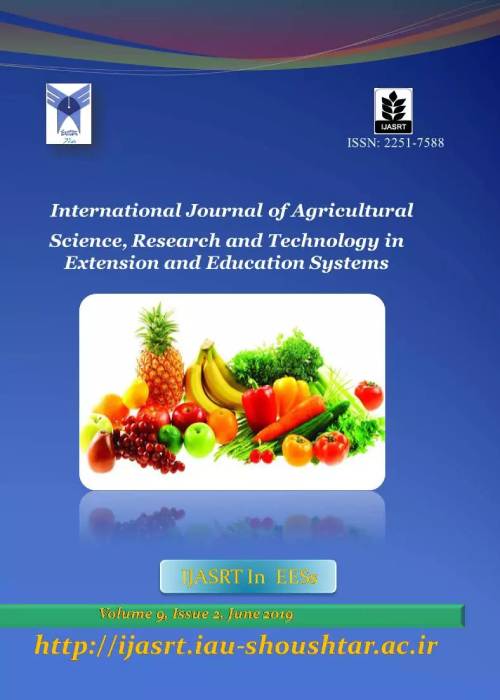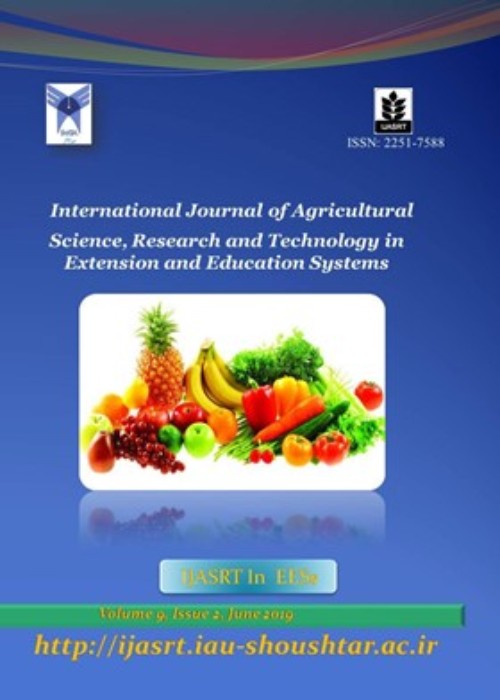فهرست مطالب

International Journal of Agricultural Science Research and Technology in Extension and Education Systems
Volume:13 Issue: 3, Sep 2023
- تاریخ انتشار: 1402/06/10
- تعداد عناوین: 6
-
Pages 131-143
Today, due to the effective role of higher education in building a knowledge economy, varied missions and expectations have been assigned to the university. Accordingly, the university must, with the long-term support of economic development through the production of knowledge, and the mechanism of technology transfer, affect the economies of countries and promote their economic prosperity. In this context, it is merely an entrepreneurial university that, as a third-generation university with a more Transcendental duty than traditional universities, ensures a better university capacity in response to changes and expectations, Such as improving the job skills of graduates and reducing the number of unemployed graduates, especially in agriculture. The Iranian agricultural sector, being one of the most important sectors of the economy, desperately needs to develop and improve, therefore, building Entrepreneurial Agriculture and Natural Resources University (EANRU) and making fundamental changes in current universities is more urgent. Therefore, this study aims to identify the necessities of creating a university using the qualitative paradigm. The statistical society was comprised of 37 faculty members of the Iranian Higher education Centers. Grounded theory was used to collect data. Snowball sampling method was used. The conceptual model of entailments for creating EANRU was developed after reaching the theoretical saturation, open coding, axial coding and eventually selective coding. Finally, practical suggestions for implementing the model were presented.
Keywords: Entailments, Higher education in Agriculture, entrepreneurship -
Pages 145-157The adoption of improved farming practices plays a crucial role in enhancing agricultural productivity and ensuring food security for smallholder farmers. This research aimed to analyze how socio-demographic factors influence the adoption of these practices in the Dodoma Region, Tanzania. Through a mixed-methods approach, data were collected from 399 sorghum farmers in the region using questionnaires and interview guide. The adoption quotient was used to measure the results, revealing that 14.79% were non-adopters, 39.35% were low adopters, 16.04% were medium adopters, and 29.82% were high adopters of improved sorghum farming practices. Analyzing the data with a linear mixed model, it was found that only two socio-demographic factors—farming experience and information seeking behavior—had a statistically significant positive influence on the adoption of improved farming practices (p-value < 0.05). These findings emphasize the need to consider the local context when promoting adoption and recommend tailored interventions to address region-specific challenges faced by farmers. Designing strategies to promote adoption should account for local environmental conditions, socio-cultural factors, and economic considerations. It is important to customize the dissemination of agricultural information to suit the unique needs of different socio-demographic groups, taking into account factors such as education levels, age groups, gender, and the specific challenges posed by the local environment.Keywords: Communication media, Farming practices, Information
-
Pages 159-164The main purpose of the current research was to identify the barriers of science and technology parks (STPs) in the development of agricultural technology in Iran. The statistical population of this research were 824 managers of agricultural companies, and 180 people were selected as a sample using Cochran's formula and selected by stratified random sampling. The validity of the research tool was determined through a panel of experts and its reliability was determined through the calculation of Cronbach's alpha coefficient. This coefficient was higher than 0.7 for all sections. In order to measure the barriers of STPs in the development of agricultural technology, 26 items were proposed and evaluated based on manager's views. The obtained results show that seven factors explain 65.697 percent of the barriers of STPs in the development of agricultural technology. The first factor with eigenvalue of 8.671 and explained about 12.568% of the variance related to barriers, was named as "organizational barriers ". The next barriers were named as "economic and financial barriers", weakness in risk management", "Management barriers", "social and cultural barriers", "scientific barriers" and "attitudinal barriers", were named.Keywords: barriers, Science, Technology Parks (STPs), Agricultural Technology, Iran
-
Pages 165-177The study examined the impact of off-farm work adoption on productivity-enhancing inputs (fertilizer and herbicide) in Southwest, Nigeria. Treatment effects model which addresses selection bias issue while considering observed and unobserved factors was used in the analysis of the data collected from sampled respondents. Endogenous Switching Regression (ESR) Model was also employed for the purpose of carrying out a robustness check. Empirical findings from the study showed that years of formal education and membership of cooperative society increased the likelihood of adopting off-farm work. Also, the study confirmed the positive role of extension services in investing in productivity-enhancing inputs as number of extension visits increased level of fertilizer expenditure in the study area. Furthermore, the study clearly showed that off-farm work adoption had direct and significant impact on both fertilizer and herbicide expenditures with the marginal effects of 6.1300 and 3.1023, respectively. Therefore, policies that promote off-farm work adoption should be put in place by all the concerned authorities in the study area. The findings that emanate from this research exercise give valuable supports to the policy architects in coming up with social and agri-environmental policies.Keywords: Off-farm work, Fertilizer, herbicide, arable crop, treatment effects model
-
Pages 179-194
High-value market chains are regarded as one of the country's lucrative market segments. However, various constraints hinder the effective involvement of smallholder farmers in these market chain, thus limiting their ability to generate income for their households and livelihood. The objective of this paper was to examine the influence of socio-economic factors on the participation of smallholder vegetable farmers in high-value markets (HVM). The study used a cross-sectional research design, involving a sample of 384 respondents. Data collection involved the use of structured questionnaires, focus group discussions, and key informant interviews. The study applied a probit model to assess these factors. Findings reveal that socio-economic factors including access to information, distance to the market, availability of extension services, and crop diversification significantly (p < 0.05) influence the participation of smallholder farmers in HVM. To enhance the participation of smallholder vegetable farmers in HVM, the study recommends that the government and agricultural organizations invest in extending agricultural extension services to remote farming areas. Additionally, efforts should focus on enhancing transportation infrastructure. Furthermore, the study suggests facilitating the dissemination of market information to smallholder farmers through information centers, mobile apps, or SMS services, to provide them with real-time market updates. Lastly, promoting specialization in crop production is encouraged. These combined measures can empower smallholder farmers, leading to increased participation in high-value markets, ultimately resulting in improved economic outcomes and livelihoods.
Keywords: Market participation, High-value market, Smallholder vegetable framers, Social-economic factors -
Pages 195-202
The present study was endeavored to focus useful information on profitability and problems of farmers in duck farming. A structured interview schedule was used to collected data from 100 randomly selected duck farmers (10% of total population) during January to May 2020 from haor areas i.e., Tarail and Itna upazila (sub-district) under Kishoreganj district in Bangladesh. Data were analyzed by utilizing both descriptive and inferential statistics. According to the analysis, the total cost of 550 ducks was assessed to be Tk. 72889.8 per lot. Average gross return, average gross margin and average net returns for 550 ducks were assessed to be Tk. 121720, Tk. 57,725.7 and Tk. 48830.2 per lot, respectively. The benefit cost ratio for duck raising was calculated to be 1.67. The findings indicated that majority of the duck farmers (74%) faced high problems, while 21% and 5% of them faced medium problem and low problem in duck farming, respectively. Among difficulties of the duck growers, outbreak of disease was the most common problem followed by high price of feed in the study area. Correlation analysis indicated that out of nine selected characteristics of the duck farmers level of education, family size, annual income, and social mobility showed negative significant relationship with the problem confrontation while the mortality of ducks and number of ducks reared by the farmers showed positive significant relationship for the same. The study revealed some prospects for the policymakers to address the above significant characteristics for profitable duck farming through lessening problems.
Keywords: profitability, problems, duck farming, haor areas, Bangladesh


